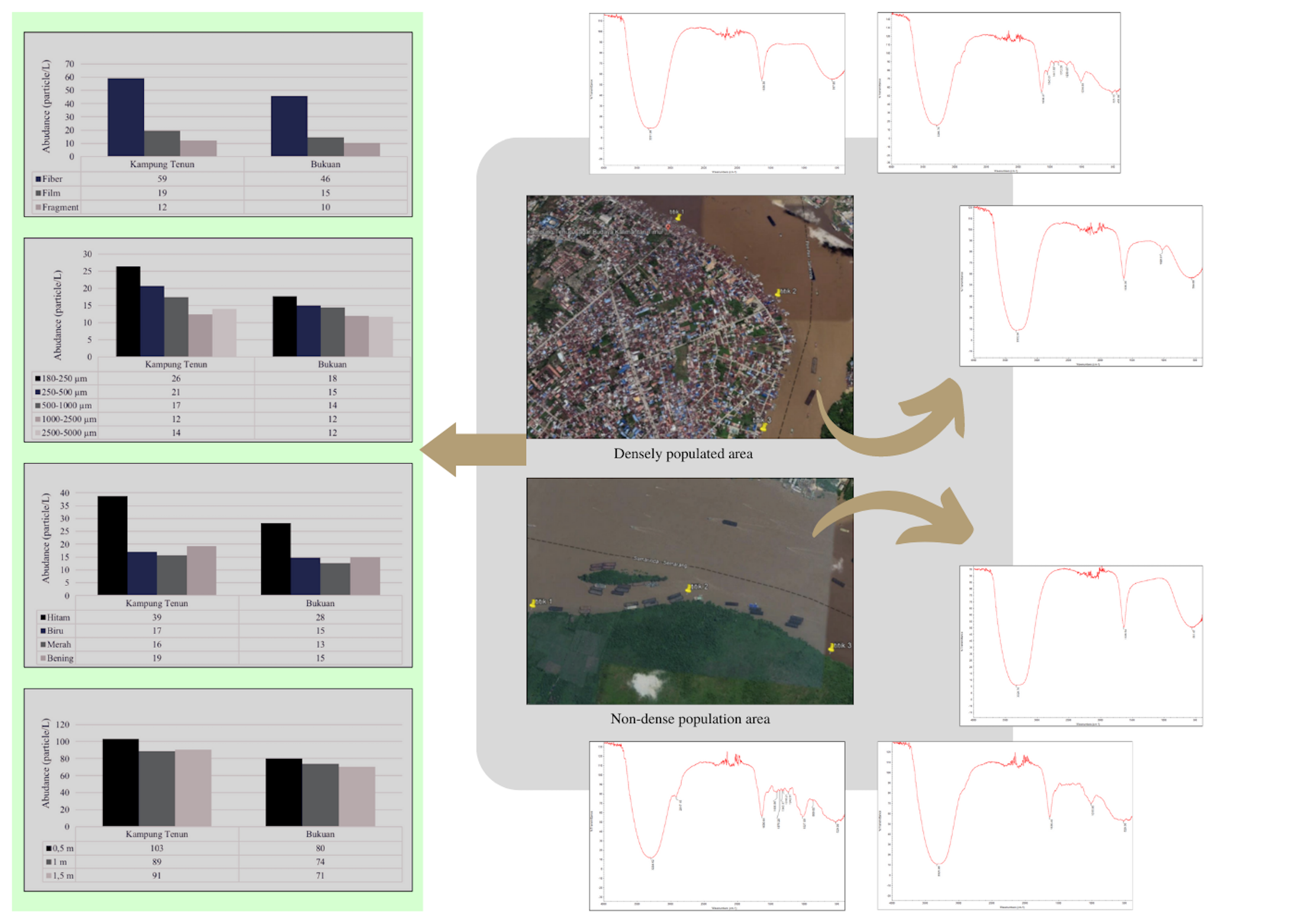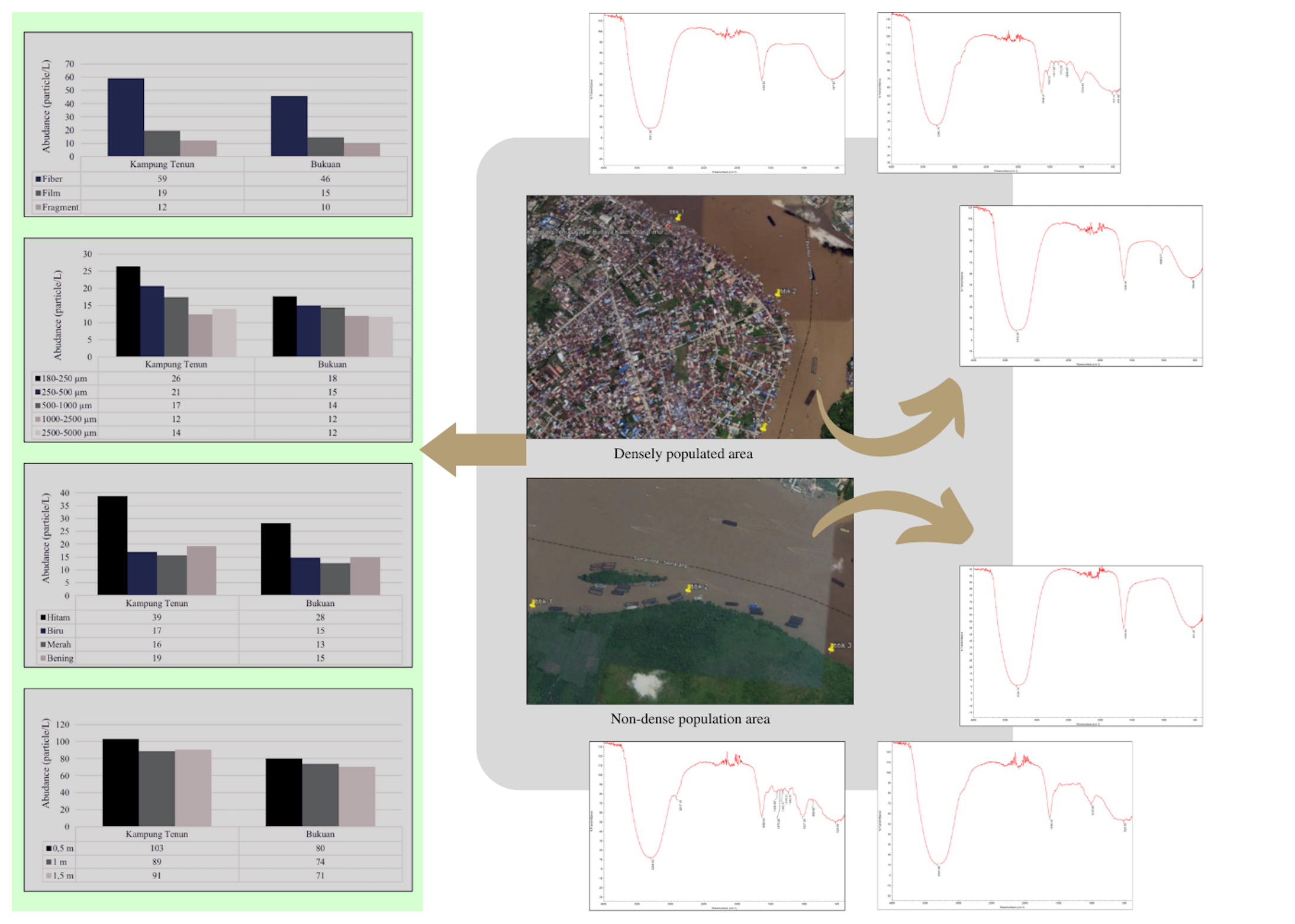Effect of Anthropogenic Type and Depth on Microplastic Abundance in Mahakam River Water, Samarinda City
DOI:
https://doi.org/10.48048/tis.2023.6423Keywords:
Microplastic, Anthropogenic, Depth, Mahakam RiverAbstract
Mahakam is the second longest river in Indonesia and it functions as a source of raw water for drinking and other essential activities for the Samarinda people. Furthermore activities in the watershed generate solid waste such as plastic, which enters the waters and is potentially degraded into microplastics. There is a possibility that the presence of microplastics is affected by anthropogenic types along the river. Therefore, this research aims to determine the effect of anthropogenic type and river depth on the microplastic abundance in the Mahakam River. The samples were taken using an integrated approach at 3 depths, namely 0.5, 1, and 1.5 m, in 2 locations with different anthropogenic types. The sampling points include Kampung Tenun and Bukuan Villages, which represented densely populated and non-populated areas, respectively. The water collected was prepared with the following steps, which include filtration with 180 μm nylon, elimination of organic matter, density separator, and final filtration. Microplastic samples were identified based on the type, color, size, and type of polymer using a microscope and FTIR. The results show that there are 3 types of microplastics, 4 colors, and 5 size categories dominated by fiber type, black, and the smallest size, respectively. There are differences in abundance in Kampung Tenun and Bukuan Villages, namely 91 particles/L and 71 particles/L, indicating the effect of the anthropogenic type. Sampling depth also affects abundance, hence, the greater the depth, the lower the abundance value. It was also discovered that anthropogenic type and depth factors influence the identified polymer types. Nylon and nitrile polymer types were found at 2 locations and 3 sampling depths, but PVC, PETE, and PS were only found at certain locations. Furthermore, Bukuan Village, with a greater environmental factor value, has a smaller abundance than Kampung Tenun Village.
HIGHLIGHTS
- Anthropogenic types affect the microplastic abundance in Mahakam River water
- Sampling depth affects the microplastic abundance in Mahakam River water
- Microplastics are found in Mahakam River water in 3 forms, 4 colors, and 5 types of polymers, with a size range of 180 - 5000 µm
- Environmental factors affect the microplastic abundance in Mahakam River water
GRAPHICAL ABSTRACT
Downloads
Metrics
References
Badan Pusat Statistik Kota Samarinda. Number of PDAM customers by kind of customers in Samarinda municipality, 2016 - 2018, Available at: https://samarindakota.bps.go.id/statictable/2019/09/10/153/jumlah-pelangganpdam-menurut-jenis-konsumen-di-kota-samarinda-2016-2018.html, accessed January 2022.
DR Susanto and A Kiswantoro. Strategi Pengelolaan Wisata Susur Sungai Mahakam Berbasis Ekowisata di Samarinda (Bahasa Indonesia). J. Tour. Econ. 2020; 3, 1-10.
IBMA Dwijatenaya. The carp farming of Keramba system: Benefit analysis, production factors, and return to scale (Bahasa Indonesia). Ziraa’ah 2017; 42, 215-23.
JR Jambeck, R Geyer, C Wilcox, TR Siegler, M Perryman, A Andrady, R Narayan and KL Law. Plastic waste inputs from land into the ocean. Science 2015; 347, 6223.
VD Lestari, Suyitno and M Siringoringo. Analisis Faktor-Faktor Yang Berpengaruh Terhadap Pencemaran Air Sungai Mahakam Menggunakan Pemodelan Geographically Weighted Logistic Regression Pada Data Dissolved Oxygen (Bahasa Indonesia). Jurnal Eksponensial 2021; 12, 37-46.
AT Sutanhaji, B Rahadi and NT Firdausi. Analisis Kelimpahan Mikroplastik pada Air Permukaan di Sungai Metro, Malang (Bahasa Indonesia). Jurnal Sumberdaya Alam dan Lingkungan 2021; 8, 74-84.
MA Browne, P Crump, SJ Niven, E Teuten, A Tonkin, T Galloway and R Thompson. Accumulation of microplastic on shorelines worldwide: Sources and sinks. Environ. Sci. Tech. 2011; 45, 9175-9.
C Arthur, J Baker and H Bamford. Proceedings of the international research workshop on the occurrence, effects, and fate of microplastic marine debri. University of Washington Tacoma, Washington, 2009.
SF Hamid. worldwide distribution and abundance of microplastic: How dire is the situation? Waste Manag. Res. 2018; 36, 873-97.
T Kataoka. Assessment of the sources and inflow processes of microplastics in the river environments of Japan. Environ. Pollut. 2019; 244, 958-65.
J Sarafraz, M Rajabizadeh and E Kamrani. The preliminary assessment of abundance and composition of marine beach debris in the Northern Persian Gulf, Bandar Abbas City, Iran. J. Mar. Biol. Assoc. United Kingdom 2016; 96, 131-5.
WC Ayuningtyas, D Yona, SH Julinda and F Iranawati. Kelimpahan Mikroplastik Pada Perairan di Banyuurip, Gresik, Jawa Timur. J. Fish. Mar. Res. 2019; 3, 41-5.
Badan Pusat Statistik Kota Samarinda. Kota Samarinda Dalam Angka 2021 (Bahasa Indonesia). Badan Pusat Statistik Kota Samarinda, East Kalimantan, Indonesia, 2021.
KH Hanif, J Suprijanto and I Pratikto. Identifikasi Mikroplastik di Muara Sungai Kendal, Kabupaten Kendal. J. Mar. Res. 2021; 10, 1-6.
M Edy, B Budijono and M Hasbi. Identification of microplastics in water column at Koto Panjang Dam. Berkala Perikanan Teburuk 2022; 49, 1353-62.
J Masura, J Baker, G Foster and C Arthur. Laboratory methods for the analysis of microplastics in the marine environment. NOAA Technical Memorandum NOS-OR&R-48, Washington, 2015.
Y Pico, A Alfarhan and D Barcelo. Nano- and microplastic analysis: Focus on their occurrence in freshwater ecosystems and remediation technologies. TrAC Trends Analyt. Chem. 2019; 113, 409-25.
R Sharma, 2019. Experimental analysis of microplastics in beach sediment samples by density separation and microscopic examination. Master’s Thesis. ARCADA, Helsinki, Finland.
P Azizah, A Ridlo and CA Suryono. Mikroplastik pada Sedimen di Pantai Kartini Kabupaten Jepara Jawa Tengah. J. Mar. Res. 2020; 9, 326-32.
H Hiwari, NP Purba, YN Ihsan, LPS Yuliadi and PG Mulyani. Kondisi Sampah Mikroplastik di Permukaan Air Laut Sekitar Kupang dan Rote, Provinsi Nusa Tenggara Timur. Prosiding Seminar Nasional Masyarakat dan Biodiversitas Indonesia 2019; 5, 165-71.
J Mu, S Zhang, L Qu, F Jin, C Fang, X Ma, W Zhang and J Wang. Microplastics abundance and characteristics in surface waters from the Northwest Pacific, the Bering Sea, and the Chukchi Sea. Mar. Pollut. Bull. 2019; 143, 58-65.
Suriyanto, B Amin and S Nedi. Distribution of microplastics in sea water on the west coast of Karimun Island, Kepulauan Riau Province (Bahasa Indonesia). Berkala Perikanan Terubuk 2020; 48, 1-8.
AA Horton, W Alexander, J David, EL Spurgeon and IS Claus. Microplastic in freshwater and terrestrial environment: Evaluating the current understanding to identify the knowledge gaps and future research priorities. Sci. Total Environ. 2017; 586, 127-41.
CG Avio, S Gorbi and F Regoli. Experimental development of a new protocol for extraction and characterization of microplastics in fish issues: First observations in commercial species from Adriatic Sea. Mar. Environ. Res. 2015; 111, 18-26.
IL Nerland, H Claudia, A Ian and VT Kevin. Microplastics in marine environments: Occurrence, distribution and effects. Norwegian Institute for Water Research, Oslo, Norway, 2014.
V Hidalgo-Ruz, L Gutow, RC Thompson and M Thiel. Microplastics in the marine environment: a review of the methods used for identification and quantification. Environ. Sci. Tech. 2012; 46, 3060-75.
H Widiyatmoko, P Purwaningrum and FP Arum. Analisis Karakteristik Sampah Plastik di Permukiman Kecamatan Tebet dan Alternatif Pengolahannya. Indonesian J. Urban Environ. Tech. 2016; 7, 24-33.
MI Joesidawati. Pencemaran Mikroplastik di Sepanjang Pantai Kabupaten Tuban. Prosiding SNasPPM 2018; 3, 8-15.
MR Jung, FD Horgen, SV Orski, CV Rodriguez, KL Beers, GH Balazs, TT Jones, TM Work, KC Brignac, SJ Royer, KD Hyrenbach, BA Jensen and JM Lynch. Validation of ATR FT-IR to identify polymers of plastic marine debris, including those ingested by marine organisms. Mar. Pollut. Bull. 2018; 127, 704-16.
KV Garland. The benefits of nitrile. J. Prof. Excel. 2013; 11, 12-6.
J Narang, N Chauhan, A Singh and CS Pundir. A nylon membrane based amperometric biosensor for polyphenol determination. J. Mol. Catal. B Enzym. 2011; 72, 276-81.
Desnelli and Miksusanti. Studi Biodegradasi Blend PVC - Minyak Nabati Epoksi sebagai Salah Satu Upaya Mengurangi Pencemaran Lingkungan oleh Limbah Plastik. Jurnal Penelitian Sains 2010; 13, 13207.
J Chu, H Xingyun, K Linghao, W Ningning, Z Suhuan, H Mengchang, O Wei, L Xitao and L Chunye. Dynamic flow and pollution of antimoy from polyethylene terephthalate (PET) fibers in China. Sci. Total Environ. 2021; 771, 144643.
PPA Rizka and SR Juliastuti. Pembuatan Stirena dari Limbah Plastik dengan Metode Pirolisis. Jurnal Teknik POMITS 2013; 2, 1-10.

Downloads
Published
How to Cite
Issue
Section
License
Copyright (c) 2023 Walailak University

This work is licensed under a Creative Commons Attribution-NonCommercial-NoDerivatives 4.0 International License.






